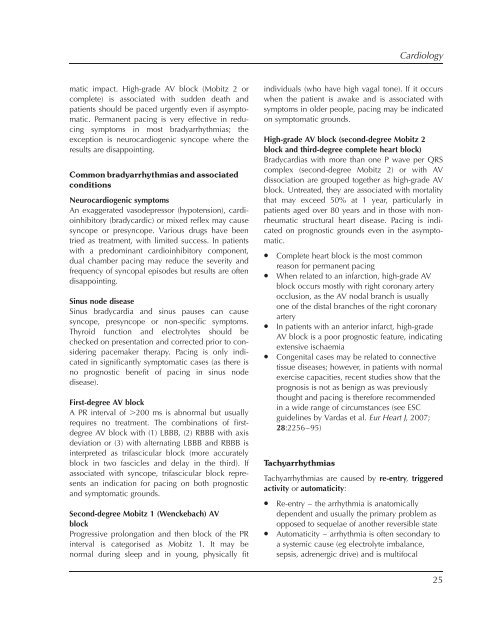Essential Revision Notes for MRCP Third Edition - PasTest
Essential Revision Notes for MRCP Third Edition - PasTest
Essential Revision Notes for MRCP Third Edition - PasTest
- No tags were found...
Create successful ePaper yourself
Turn your PDF publications into a flip-book with our unique Google optimized e-Paper software.
Cardiologymatic impact. High-grade AV block (Mobitz 2 orcomplete) is associated with sudden death andpatients should be paced urgently even if asymptomatic.Permanent pacing is very effective in reducingsymptoms in most bradyarrhythmias; theexception is neurocardiogenic syncope where theresults are disappointing.Common bradyarrhythmias and associatedconditionsNeurocardiogenic symptomsAn exaggerated vasodepressor (hypotension), cardioinhibitory(bradycardic) or mixed reflex may causesyncope or presyncope. Various drugs have beentried as treatment, with limited success. In patientswith a predominant cardioinhibitory component,dual chamber pacing may reduce the severity andfrequency of syncopal episodes but results are oftendisappointing.Sinus node diseaseSinus bradycardia and sinus pauses can causesyncope, presyncope or non-specific symptoms.Thyroid function and electrolytes should bechecked on presentation and corrected prior to consideringpacemaker therapy. Pacing is only indicatedin significantly symptomatic cases (as there isno prognostic benefit of pacing in sinus nodedisease).First-degree AV blockA PR interval of .200 ms is abnormal but usuallyrequires no treatment. The combinations of firstdegreeAV block with (1) LBBB, (2) RBBB with axisdeviation or (3) with alternating LBBB and RBBB isinterpreted as trifascicular block (more accuratelyblock in two fascicles and delay in the third). Ifassociated with syncope, trifascicular block representsan indication <strong>for</strong> pacing on both prognosticand symptomatic grounds.Second-degree Mobitz 1 (Wenckebach) AVblockProgressive prolongation and then block of the PRinterval is categorised as Mobitz 1. It may benormal during sleep and in young, physically fitindividuals (who have high vagal tone). If it occurswhen the patient is awake and is associated withsymptoms in older people, pacing may be indicatedon symptomatic grounds.High-grade AV block (second-degree Mobitz 2block and third-degree complete heart block)Bradycardias with more than one P wave per QRScomplex (second-degree Mobitz 2) or with AVdissociation are grouped together as high-grade AVblock. Untreated, they are associated with mortalitythat may exceed 50% at 1 year, particularly inpatients aged over 80 years and in those with nonrheumaticstructural heart disease. Pacing is indicatedon prognostic grounds even in the asymptomatic.• Complete heart block is the most commonreason <strong>for</strong> permanent pacing• When related to an infarction, high-grade AVblock occurs mostly with right coronary arteryocclusion, as the AV nodal branch is usuallyone of the distal branches of the right coronaryartery• In patients with an anterior infarct, high-gradeAV block is a poor prognostic feature, indicatingextensive ischaemia• Congenital cases may be related to connectivetissue diseases; however, in patients with normalexercise capacities, recent studies show that theprognosis is not as benign as was previouslythought and pacing is there<strong>for</strong>e recommendedin a wide range of circumstances (see ESCguidelines by Vardas et al. Eur Heart J, 2007;28:2256–95)TachyarrhythmiasTachyarrhythmias are caused by re-entry, triggeredactivity or automaticity:• Re-entry – the arrhythmia is anatomicallydependent and usually the primary problem asopposed to sequelae of another reversible state• Automaticity – arrhythmia is often secondary toa systemic cause (eg electrolyte imbalance,sepsis, adrenergic drive) and is multifocal25
















